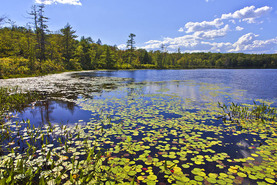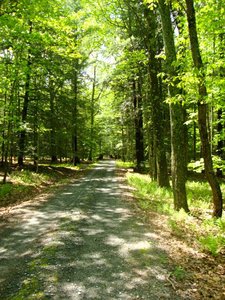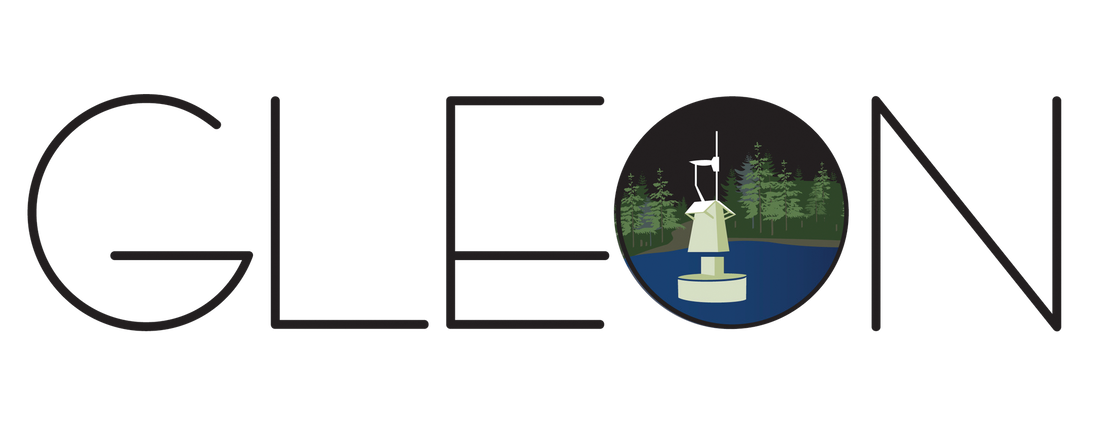Natural Features

According Arthur Watres, Lacawac Sanctuary’s founder, “Lacawac is dedicated to filling gaps in man’s knowledge of his environment and to promoting an understanding of man’s place in natural creation.”
The most notable feature of Lacawac (Lenape for “fork”) Sanctuary is the breathtaking Lake Lacawac - a 52 acre glacial lake preserved in almost pristine condition (totally free from development or encroachment).
Lake Lacawac is a National Natural Landmark by ponds, swamps, marshes, bogs, meadows and mixed hardwood-conifer forest.
The only way to see most of the sanctuary is to hike its trails. Lacawac was once covered by a glacier a thousand feet thick thirteen thousand years ago. In 1903 a coal operator from Scranton, William Connell, bought the property and a summerhouse on its four hundred acres. He also reintroduced white-tailed deer in this part of Pennsylvania by bringing some up from Virginia and enclosing them within a four-mile deer fence he had built around his land. The herd multiplied, and some deer escaped and merged with a Pike County herd that had been imported from Michigan. Today there are too many deer at Lacawac despite a yearly hunting season and signs of heavy browsing are evident in the woodland. The deer are also fond of the ten species of wild orchids, including the ragged fringed orchids, spotted coralroot, pink lady’s slipper, pale green orchids, rose pogonia, and small woodland orchids, growing on the property.
The most notable feature of Lacawac (Lenape for “fork”) Sanctuary is the breathtaking Lake Lacawac - a 52 acre glacial lake preserved in almost pristine condition (totally free from development or encroachment).
Lake Lacawac is a National Natural Landmark by ponds, swamps, marshes, bogs, meadows and mixed hardwood-conifer forest.
The only way to see most of the sanctuary is to hike its trails. Lacawac was once covered by a glacier a thousand feet thick thirteen thousand years ago. In 1903 a coal operator from Scranton, William Connell, bought the property and a summerhouse on its four hundred acres. He also reintroduced white-tailed deer in this part of Pennsylvania by bringing some up from Virginia and enclosing them within a four-mile deer fence he had built around his land. The herd multiplied, and some deer escaped and merged with a Pike County herd that had been imported from Michigan. Today there are too many deer at Lacawac despite a yearly hunting season and signs of heavy browsing are evident in the woodland. The deer are also fond of the ten species of wild orchids, including the ragged fringed orchids, spotted coralroot, pink lady’s slipper, pale green orchids, rose pogonia, and small woodland orchids, growing on the property.
Lake LacawacFifty-two-acre Lake Lacawac, the heart of the sanctuary, has been called “the southernmost unpolluted glacial lake in North America.”
Beginning in the 1950s, researchers from the Academy of Natural Sciences in Philadelphia found this lake invaluable as a field laboratory. Shaped like a half-moon, this “ice scour” lake has two distinct habitats—an organically rich bog to the west and north and sand and rock to the east and south. The latter habitat was formed by continual wave action from prevailing northwest winds and supports only a few plants. The bog, on the other hand, is rich in plants. Thirty-five crustacean species and thirty species of aquatic plants including eight rare plants have been identified in the lake. Lake WallenpaupackLacawac offers one mile of undisturbed shoreline on Lake Wallenpaupack, one of Pennsylvania’s largest recreational lakes. Lacawac’s diverse habitat is home to an extraordinary variety of native wildlife including bears, minks, otters, foxes, ruffled grouse, flying squirrels, beavers, wild turkeys, and porcupines.
On the south side of the sanctuary, a series of rocky ledges dropping 250 feet to the shores of Lake Wallenpaupack. The ledge area affords a splendid view of Lake Wallenpaupack in the winter months. It also makes a delightful spot for bird watching in the spring and summer, providing a view of the forest canopy. With the shagbark hickory, black cherry, ironwood, basswood, white ash, butternut, red oak, chestnut oak, and the lichens, mosses, orchids and ferns that grow here, the diversity of this mature forest is among the best in the sanctuary. |
Lacawac’s Forest
Lacawac Sanctuary preserves over 500 acres of forest. Most of it is second growth although some traces of original forested areas exist within the practical protection areas of the boreal bog and on the high side of the Wallenpaupack Ledges.
We currently manage the forest aggressively to encourage regeneration of old growth and habitat variety for various species of flora and fauna. The areas around the trails are also managed for scenic, recreational value. Read more on regeneration of old growth forests in The Nature Conservancy’s Old Growth Forest Theory. Currently our forest is under attack. Threats include outbreaks of gypsy moth caterpillars, tent caterpillars, wooley adelgid, and a few years back we had wind damage to the larger hemlock trees near the lake. There are also areas where foreign invasive plant species such as the hay scented fern choke back native seedling propagation. Lacawac has two permanent deer exclosures on the property which may be viewed off of the Ledges Trail. Deer have been excluded from these plots since 1996 as part of a scientific experiment to investigate the impact of deer on forest regeneration. Read more about Lacawac’s Forest Stewardship Plan. Heron PondHeron Pond is a small impoundment located behind the Watres Environmental Education Center. The pond is home to a variety of wildlife, including diverse aquatic plants, macroinvertebrates, amphibians, fish, and turtles. An osprey pole is located on the far shore and hosts a breeding pair each spring.
Research and Planning Maps |




































